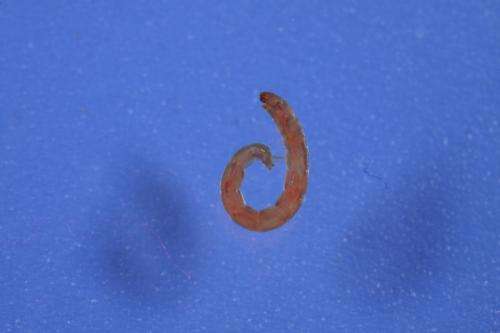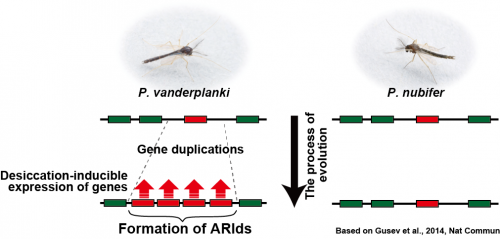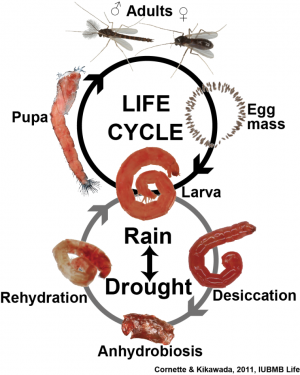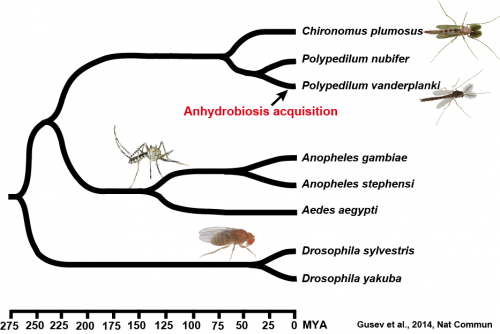Researchers decipher genetic mechanism that makes the midge invulnerable to harsh conditions

New collaborative research published in the journal Nature Communications by scientists from Japan, Russia and the US contains the genetic analysis on a species of African midge, which can survive a wide array of extreme conditions including large variations in temperature, extreme drought and even airless vacuums such as space. The team successfully deciphered the genetic mechanism that makes the midge invulnerable to these harsh conditions. Prof. Noriyuki Satoh and Dr. Takeshi Kawashima of Prof. Satoh's Marine Genomics Unit, as well as Prof. Alexander Mikeyhev of the Ecology and Evolution Unit, and Mr. Manabu Fujie and Dr. Ryo Koyanagi of the DNA Sequencing Section at the Okinawa Institute of Science and Technology Graduate University have contributed to the collaboration.
The midge, Polypedilum vanderplanki, is capable of anhydrobiosis, a unique state that allows an organism to survive even after losing 97% of its body water. Anhydrobiotic organisms are also able to survive other severe conditions such as extreme temperatures ranging from 90°C to -270°C, vacuums and high doses of radiation; all of which would be lethal to most other life forms.
The midge found in northern Nigeria lives in an environment where the dry season lasts for at least six months and droughts can last up to eight months. By the time eggs have hatched and larvae have developed, the pools of water they breed in have dried up. However these dried larvae can survive in this dehydrated state for more than 17 years. "This is a very interesting kind of phenomena," remarks Prof. Satoh. "The first descriptions of this midge were more than 60 years ago… But serious research started only ten years ago."
While there are other organisms which are anhydrobiotic, what makes this midge unique is its genetic makeup. Comparative analysis between P. vanderplanki and one of its closer relatives, Polypedilum nubifer, shows significant variations in the genes connected with anhydrobiosis. The results of the study show that many of the genes P. vanderplanki possess are exclusive to its genetic code and not something passed down from an ancestral species nor are they shared by its close relatives. This means that the midge is not just unique, but an excellent resource for study as those exclusive gene sequences possessed by P. vanderplanki are readily identifiable in gene clusters known as Anhydrobiotic Related gene Islands (ARId's).

The extent of dehydration that these midges can withstand can very badly damage DNA. However organisms like P. vanderplanki have the ability to make significant structural repairs to their DNA after being rehydrated. Another collaborator, Dr. Takahiro Kikawada of the National Institute of Agrobiologial Sciences in Tsukuba, Japan points to interesting previous results published in PLOS ONE, where larvae had restored physiological activity within an hour after rehydration, and nuclear DNA restoration between 72 and 96 hours after rehydration.
The potential applications for such genes could revolutionize the way biological specimens and samples are stored and transported around the world. The possible infusion of such genes with medical samples such as fertilized eggs and blood samples, would give researchers greater flexibility in contingency plans for long term storage. The transportation of very sensitive biological samples between laboratories could be made dramatically easier and more cost effective in dehydrated states.
-

The flow chart shows the different cycles the midge takes through cycles of long drought in Africa. The reintroduction of water into the environment triggers the switch between cycles where seemingly mummified larvae can come back to life. -

The genes responsible for making Polypedilum vanderplanki as resilient as it is are unique genetic mutations that have only been found in this particular species.
More information: "Comparative genome sequencing reveals genomic signature of extreme desiccation tolerance in the anhydrobiotic midge." Oleg Gusev, et al. Nature Communications 5, Article number: 4784 DOI: 10.1038/ncomms5784
Gusev O, Nakahara Y, Vanyagina V, Malutina L, Cornette R, et al. (2010) "Anhydrobiosis-Associated Nuclear DNA Damage and Repair in the Sleeping Chironomid: Linkage with Radioresistance." PLoS ONE 5(11): e14008. DOI: 10.1371/journal.pone.0014008
Journal information: Nature Communications , PLoS ONE
Provided by Okinawa Institute of Science and Technology






















